Plunging dramatically into the chilly waters of the North Atlantic, Portugal was, for centuries, considered the end of the world. Although explorers (many of Portuguese descent) eventually determined otherwise, Europe’s westernmost nation still feels like it lies at the edge of nowhere. A perfect mix of European sensibility crossed with untamed natural beauty, the country has become the ultimate adventure destination for hikers, surfers, divers and kiteboarders alike.
If you’re still pondering a trip to Portugal, this guide is a must-have. In it, we will cover:
- Why Visit Portugal?
- The Top Outdoor Activities in Portugal
- The Best Places to Visit in Portugal
- How to Plan Your Trip to Portugal
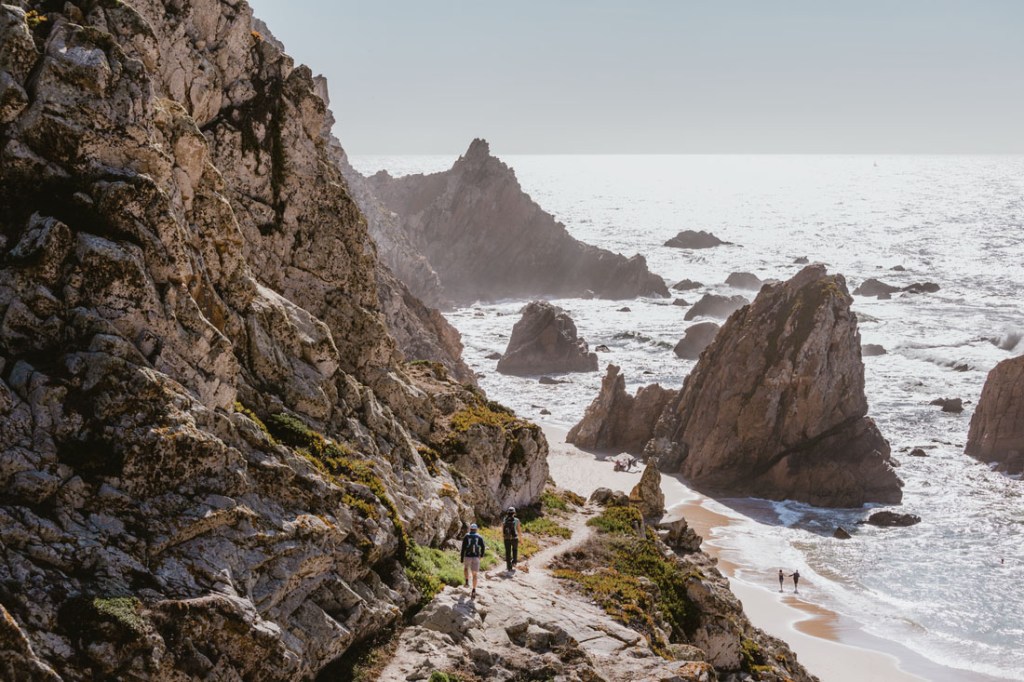
Portugal’s rugged coastline serves up a triple-threat of surf, scenery and world-class hiking.
Portugal features all of the comforts of European travel—euros, easy transcontinental connections and no tourist visa requirements, to name a few—while maintaining a streak of the exotic. From cliff-lined beaches to some of the continent’s oldest cities, its very own music and a singular culinary culture, Portugal is a unique gateway to a different type of European excursion.
Why Visit Portugal?
Portugal may barely be the size of Virginia, but what it lacks in size, it makes up for in sheer variety. With hundreds of miles of coastline, Portugal has a beach for every taste, whether it be the turquoise lagoons in the country’s southwest, or the proving grounds of big-wave surfing farther north. Portugal is also home to Lisbon and Porto, two of Europe’s oldest cities, but also some of its most dynamic, where traditional architecture lives next to street-art murals and eclectic outdoor cafés.
Because of its western orientation, Portugal has long been a passageway between Europe, Africa and the Americas. In other words, Portuguese people are accustomed to visitors and are typically open and friendly with international travelers. While Portuguese is the country’s official language, many residents speak English, and getting around the country without its native tongue is very manageable, even for new international travelers.
But where Portugal really sets itself apart from the rest of Western Europe is in the wallet department. Even though the country operates on the euro, it’s consistently one of the most (relatively) affordable destinations on the continent, meaning meals, lodging and transportation are often a whole lot cheaper than in surrounding countries. At the time of this writing, a three-course dinner will cost close to $15 and city metro rides are rarely over $1.
The Top Outdoor Activities in Portugal
Hiking
Portugal is home to its fair share of noteworthy hiking and trekking. Whether it be walking the country’s very own Camino de Santiago (known as the Camino Portugués), or trekking to the “End of the World” at Portugal’s southwestern tip along the Rota Vicentina, there is a trail for every taste.
Camino Portugués: Portugal’s own Camino de Santiago starts in Lisbon and passes through Lisbon before winding its way into the Spanish city of Santiago de Compostela. This trek covers nearly 400 miles and cuts through lush river valleys, sprawling countryside, and beautiful coastline in addition to holding significant religious importance within the country.
Rota Vicentina: This network of hiking trails navigates the pristine beauty of the Algarve region in southwestern Portugal. Stretching along one of the best preserved coastlines in all of Europe, the Rota Vicentina is packed with jagged cliffs, sweeping ocean views, and a vast array of flora and fauna unique to the region. All trails lead to Cabo de São Vicente, the dramatic southwestern tip of Europe once considered the end of the modern world.
Madeira: This Portuguese island chain is normally recognized for its beaches, but Madeira’s steep volcanic relief makes it a special destination for hikers as well. Pico Ruivo rises over 5,000 feet above sea level, and features several well-marked trails of varying difficulty.
Keep in mind that Madeira is a group of islands and will require additional air travel.
Surfing
With copious amounts of sunshine and a wave for every ability level, Portugal is Europe’s surf destination. In fact, Portugal’s most-landlocked point is only 120 miles from the coast, meaning there is always a surf beach within a few hours’ drive.
Portugal’s surfing ranges from fast, reef point breaks to mellow beach surf to some of the world’s most awe-inspiring big waves, with spots stretching from the humid north to arid south and out on the Atlantic island chains of Madeira and the Azores.
In addition, the country prides itself on its clean beaches, with at least 300 reaching Blue Flag status (a widely recognized standard for water quality and environmental responsibility outside of the U.S.), providing some of the cleanest surf in the world.
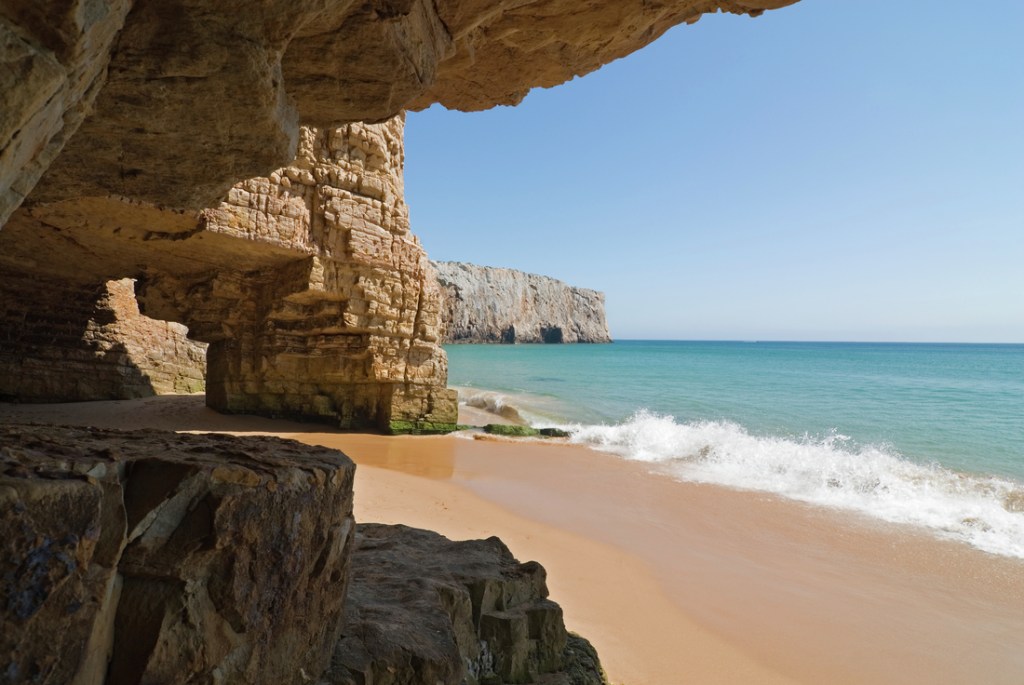
Pristine stretches of beach provide surfers ample opportunity to find the perfect wave.
Some of the most popular surf destinations in Portugal include:
Carcavelos is Lisbon’s go-to surf beach. Located just off the metro, this sandy beach is easy to get to from the city center and has a series of fun, rideable waves for beginner and intermediate surfers. The beach is also lined with surf shops and restaurants, making it easy to rent a wetsuit and board, get a lesson and wash it all down with a post-surf meal.
Praia da Arrifana is located in the town of Aljezur in Portugal’s Algarve region, three hours south of Lisbon. A crescent of sand squeezed between tropical blue waters and sandstone cliffs, this spot is built for postcards as much as it is for surfing. Luckily, the waves deliver, as the beach’s half-moon shape picks up most swell while blocking wind. For beginners, there are a few surf schools in town that offer lessons and rentals.
Praia do Cabedelo sits on the south side of Figueira da Foz, a coastal city less than an hour and a half from Porto. The surf beach is popular with intermediates and experts, offering a long, right-hand wave with expansive sand dunes as its backdrop. In September 2019, the beach will become the first night-surfing destination in Europe, illuminating its break with 21 light projectors across multiple floodlight towers.
Cantinho da Baia may sit in the cradle of big wave surfing in between Porto and Lisbon, but this mellow beach break is excellent for beginners. Featuring nearly two miles of beach, the area spreads out surfers and offers a friendly wave at any tide.
For those interested in watching surfing, nearby Peniche hosts international surf competitions every fall, and Nazaré, home to the biggest surf waves in the world, is less than an hour away by car.
Ribeira d’Ilhas: For the intermediate surfer who dreams of riding that one, perfect wave into eternity, look no further than Ribeira d’Ilhas. Located less than an hour north of Lisbon, this reef break picks up west and northwest swell and is known as one of the longest right-hand waves in Europe. The nearby fishing village of Ericeira is a great place to sample Portugal’s legendary seafood.
Scuba Diving
Despite its cold waters, Portugal is a diverse diving location for any level of diver. The country has 71 Marine Protected Areas (zones designated to protect species and ecosystems while promoting sustainable eco-tourism), providing unparalleled diving adventures just off the mainland coast. Because of its jagged coastline and sweeping storms, Portugal has hundreds of shipwrecks to explore, and abundant wildlife. Madeira, its westerly island chain, offers warmer and clear waters, but requires a separate plane ride from the mainland.
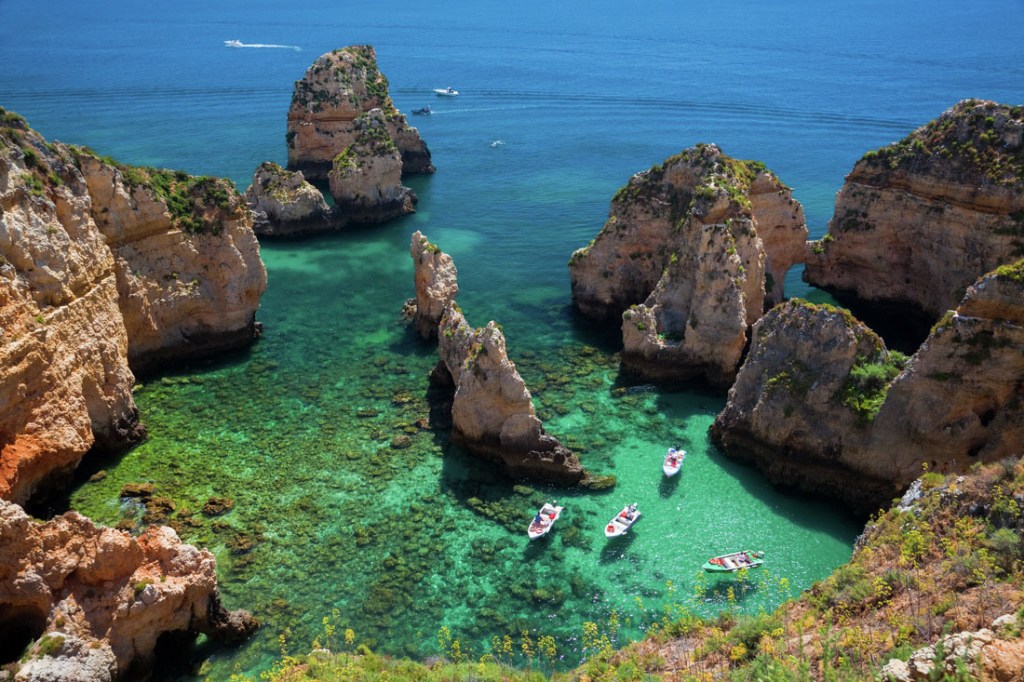
The crystal-clear waters of Portugal are ideal for underwater marine exploration.
Portugal’s scuba infrastructure is strong as well, with diving tour operators and certification specialists available up and down the coast.
Kiteboarding
Portugal’s abundant coastline comes with its fair share of wind. While that may signal a moment of pause for the average beach tourist, it has proved a blessing for kitesurfers, as Portugal has emerged as an up-and-coming destination for the extreme sport. Just a 30-minute train or car ride from Lisbon, Praia do Guincho near the resort town of Cascais is an idyllic kiting location that offers rentals and lessons from a selection of kite-specific shops, including SB Kiteboarding, one of the best known kite operations in the country. Both the north and south also have a variety of kiting beaches.
The Best Places to Visit in Portugal
Lisbon
Portugal’s beating heart, the nation’s capital is a confluence of history, art, music and cuisine sure to satiate every traveler’s palate. Known locally as the City of Seven Hills, Lisbon is built on steep hillsides connected by narrow staircases and cable cars that give way to sweeping views of the city and the Tagus River below.
Some of the most popular things to do in Lisbon include:
Castelo de São Jorge: Like Rome, Lisbon is a city of many hills and even more viewpoints. One of the most famous views is from the walls of Castelo de São Jorge, a castle built by the Moors in the 10th century over even older structures. To reach the castle, visitors can take tram line 28 or brave the stairs from Praça dom Pedro IV (a great excuse to check out the city’s vibrant street art scene).
Alfama: Tucked under the Castelo de São Jorge, this neighborhood was one of the only to survive the devastating earthquake and tsunami of 1755. Originally the city’s district, the neighborhood is a maze of streets, alleys and steep steps packed full of restaurants, shops and lively nightlife.
Museu Arqueológico do Carmo: Once one of Lisbon’s oldest churches, the Igreja do Carmo was nearly destroyed by the 1755 earthquake. Today a small architectural museum sits in the skeleton of the church’s old nave, overlooking the beautiful Largo do Carmo plaza.

Communal meals and fine wines are a staple of traveling in Portugal.
Mosteiro dos Jerónimos: A monument to Portuguese explorers and the Age of Discovery, this 16th-century monastery is one of the most culturally significant landmarks in Portugal and a UNESCO World Heritage site.
Experience Fado: Portugal’s tortured-love music has become famous worldwide, but Lisbon is one of its epicenters. The Clube de Fado has hosted some of the most famous fado artists in history and still hosts weekly shows for locals and tourists alike.
Catch Lisbon’s soccer derby: Watch one of the city’s two professional soccer teams in action, or, if you’re lucky, catch them both during one of their classic derbies. Lisbon is proud of its two clubs, S.L. Benfica and Sporting CP, but on derby day, the whole city picks sides, making for one of the most exciting intracity rivalries in sports.
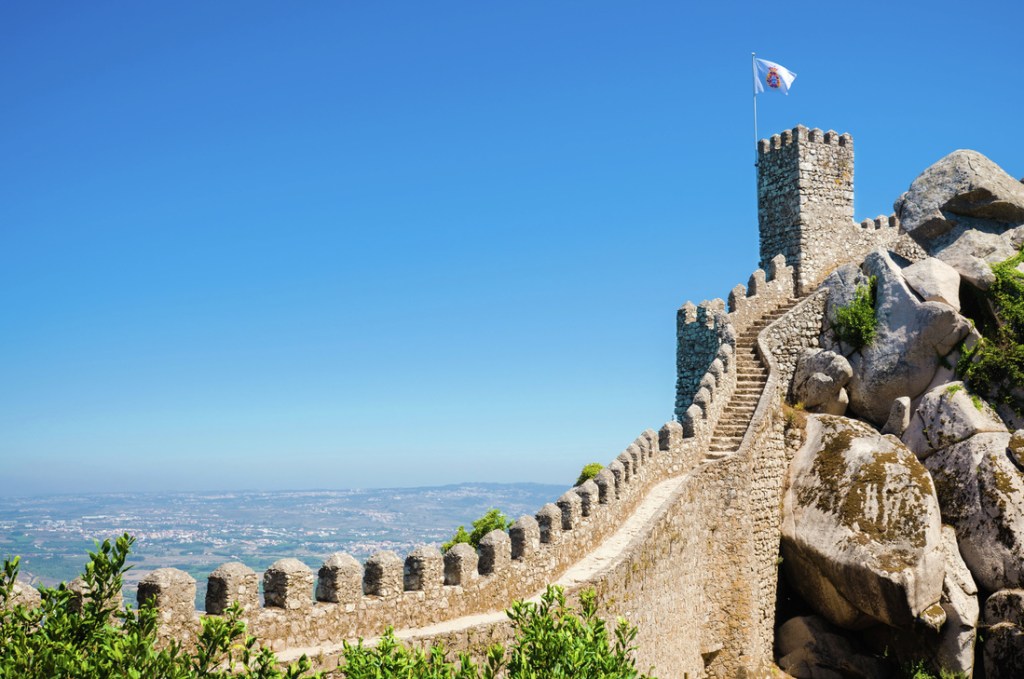
Sintra’s Castle of the Moors helped earn the area a UNESCO World Heritage designation in 1995.
Sintra: Take a 40-minute train ride outside of Lisbon to this compelling town set in forested hills. Sintra received a UNESCO World Heritage designation in 1995 for its “cultural landscape,” the first of its kind in Europe. Its most popular attraction is the Pena Palace, a collection of brightly colored buildings overlooking the Atlantic, including a Moorish castle, used as the Portuguese royal family’s summer residence.
Porto
Set along the beautiful Douro River, Porto has a more historical feel than its metropolitan brother to the south. A maze of red tile roofs, tight streets and quirky storefronts, Portugal’s second biggest city is at once mysterious and romantic.
Home to port wine and a rich menu of fresh seafood, Porto is known as Portugal’s food capital, and an excellent way to unwind after buzzing around the country’s busier capital city.
Some of the most popular things to do in Porto include:
Livraria Lello: Regarded as one of the most beautiful and oldest bookstores in the world, this locale is a testament to Porto’s rich literary culture. It is said to have inspired the Flourish and Blotts bookshop in Harry Potter.
Cais da Ribeira: Porto’s bustling riverfront is cut straight from an impressionist painting, where tourists and locals go to sample restaurants, local handicrafts and wine on a waterside promenade.
Jardins do Palácio de Cristal: Modeled after the Crystal Palace Monument in London, these gardens offer up tree-lined walkways, sculptured topiaries and an overlook of the Douro River that can’t be missed.

Wine not? Home to port wine, Porto has some of the finest vintages in the world.
São Bento Train Station: Whether in transit or just taking a look, Porto’s main train station has been voted one of the world’s most beautiful, featuring an interior of decorative tile murals that detail Porto’s rich history.
Tour a port wine cellar: Chiseled into caves along the south bank of the Douro River in Vila Nova de Gaia, a collection of wine cellars specializing in Porto’s port wine offer a history (and a taste) of Portugal’s most famous export.
Foz do Douro: Perched where the Douro meets the seas, Porto’s satellite township offers up shops, cafes and beaches that seem a world away from Porto’s downtown. The town is also home to the Felgueiras lighthouse, which guided ships safely into harbor until 2009.
The Azores
Worthy of a guide all its own, the Azores is a remote island chain that tickles the edge of fantasy and reality. These impossibly green volcanic islands feature rugged and dramatic landscapes of mountains, cliffs, waterfalls and lakes that have earned it comparisons with Iceland as one of the greatest untamed wildernesses left on the planet.
Though the islands are often in the path of large tropical storms or shrouded in clouds, when the weather breaks, the Azores are an experience unlike anything else.
Here are some of the most popular things to do in the Azores:
Hiking the Caldeira das Sete Cidades: A verdant volcanic caldera that forms one of the most picturesque crater lakes in the world. The crater offers up viewpoints from every direction, as well as hiking trails for all levels.
Hiking Montanha do Pico: The highest point in all of Portugal, this stratovolcano was active as late as 1718, but is currently a popular hiking destination with views of several Azores Islands on clear days.
Exploring the Islote da Vila Franca do Campo: A short ferry ride from the Azores main island of São Miguel (or a quick kayak), this nearly-submerged caldera barely pokes out of the Atlantic Ocean, offering a tantalizing lagoon for warm-water swimming and snorkeling surrounded by steep walls of vegetation.
Exploring the Algar do Carvão: For anyone that wants to get a little closer to the Azores’ volcanic past, hike into the Algar do Carvão’s 300-foot-deep lava tube and emerge into the extinct volcano’s hollow magma chamber.
Lagos
A seaside oasis tucked into the southwestern corner of Portugal’s Algarve region, Lagos is a jump-off point for international adventurers. In addition to its remote, cliff-lined beaches and emerald waters, Lagos offers scuba diving, cliff jumping and deep-water soloing—where climbers scale cliffs overhanging the ocean without any gear.
In recent years, Lagos has become a destination for adventure travel and is now home to a wide selection of restaurants and lodging options.
How to Plan Your Trip
Best times to visit
In general, Portugal shines during the late spring and early fall shoulder seasons.

A hiker enjoys the fine weather of the summer months.
While cool sea breezes keep the country pleasant during hot Iberian summers, Portugal receives an influx of European tourist traffic from late June until the end of August (most Europeans dedicate the month of August to vacations). On the opposite end of the spectrum, late November through March is a distinct rainy season in Portugal–not exactly ideal for that beach getaway.
The best times to visit are from late April until mid-June, and from early September until early November. Late spring is also festival season in Portugal, which may increase some expenses, but will most definitely increase the cultural experience.
Typically, shoulder season high temperatures hang between 70 and 85 degrees Fahrenheit.
Where to stay
Lodging in Portugal ranges from highly ranked hotels to bed-and-breakfasts to backpacker hostels, with a wide variety of options in major metropolitan areas and small towns alike.
Portugal is also home to pousadas, a collection of once-government-controlled hotels and inns in historic buildings like medieval palaces and castles throughout the country that are now run privately.
In recent years, international backpackers have flocked to Portugal, where it’s quite easy to find a hostel bed for under $15 a night. For the more road-savvy adventurer, van camping is also free in designated parking areas known as “Areas para Autocaravanas.”
What to pack
Remember that even though Portugal experiences nice weather throughout most of the year, conditions can get cool and windy along the coast. Here are a few items that need to be in your pack:
- Surf booties / gloves (if you’ll be surfing)
- Windbreaker
- Comfortable walking shoes (or boots if you’ll be hiking)
- Sunscreen and hat
- A shawl or scarf

Most churches and cathedrals in Portugal require covered shoulders, so remember an extra layer.
No matter how sunny it gets, many cathedrals and churches adhere to a dress code and require shoulders to be covered before entry. Remember to keep a light layer in your pack to throw over your summer tops.
Getting from place to place
There are several transportation options in Portugal, including:
Rideshares: Without a doubt, the cheapest way to get around Portugal is via rideshare. Popular rideshare app BlaBlaCar will get you almost anywhere in the country and beyond (rides can extend throughout Europe), for the cost of a little gas money. Simply search your trip and pick your driver based on his or her in-app peer ranking. Secure payment options are available through the app as well, so there is no physical exchange of money or awkward travel encounters.
Train: Unsure about sharing a ride? Portugal’s rail system is well-connected and offers a variety of timetables for each route. As in all of Europe, partial and full transit strikes occur semi-frequently, so be sure to check if your trip is affected before heading to the station.
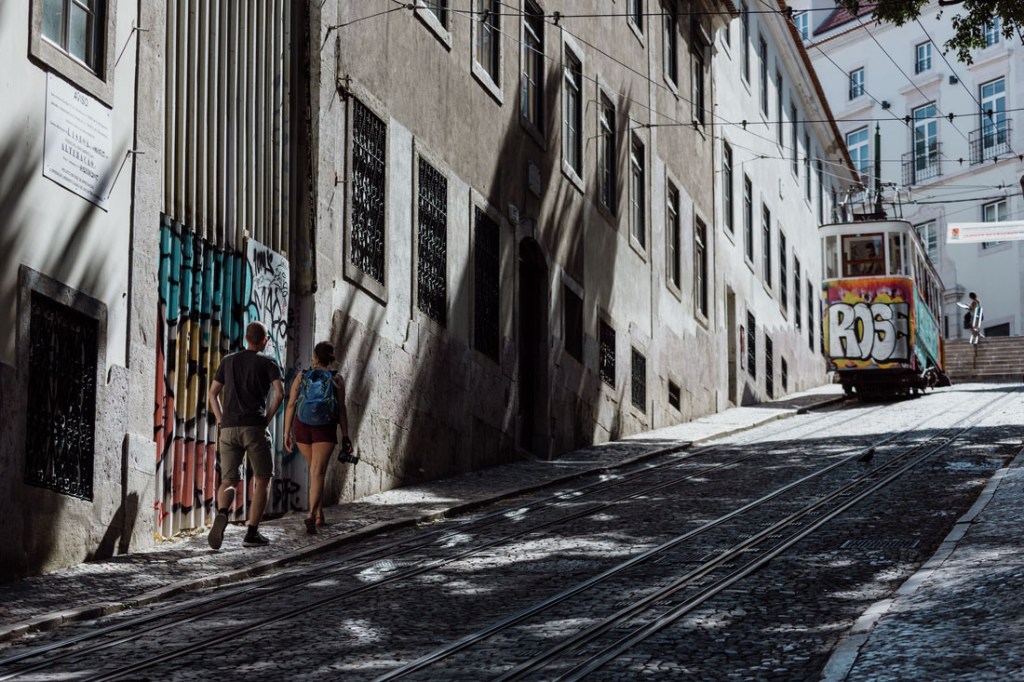
In Lisbon—the City of Seven Hills—cable cars are a popular means of transport.
Trolley: While both Porto and Lisbon have a well-established metro system, the most fun (and cheapest) form of public transportation are the cities’ streetcars. Similar to the trolleys in San Francisco, these surface rails give you a nice perspective of the city while traveling from point to point for a little over 2 euros. Hot tip: Buy the 24-hour ticket in Lisbon, and ride all day for just 5 euros.
Money: Like most of Europe, Portugal operates on the euro. However, the country still honors its past banknote, the escudo, and will do so until 2022.
Skip the temptation of exchanging money at the airport (these travel hubs are notorious for offering the poorest exchange rates) and head to an ATM in town to withdraw euros. Better yet, check if your hometown bank has any partnerships with Portuguese banks to see if you can reduce your ATM fees abroad.
What to eat and drink
Portugal has long been a destination for European foodies, and for good reason. Its location along the coast has given birth to a lasting seafood tradition, and bacalao (the flavorful cod fish native to the North Atlantic) and sardines can be found in just about any form—all of them tasty. In fact, every June, Lisbon celebrates its favorite salty fish for an entire week, hosting a sardine festival in conjunction with the celebration of its patron saint, Saint Anthony.
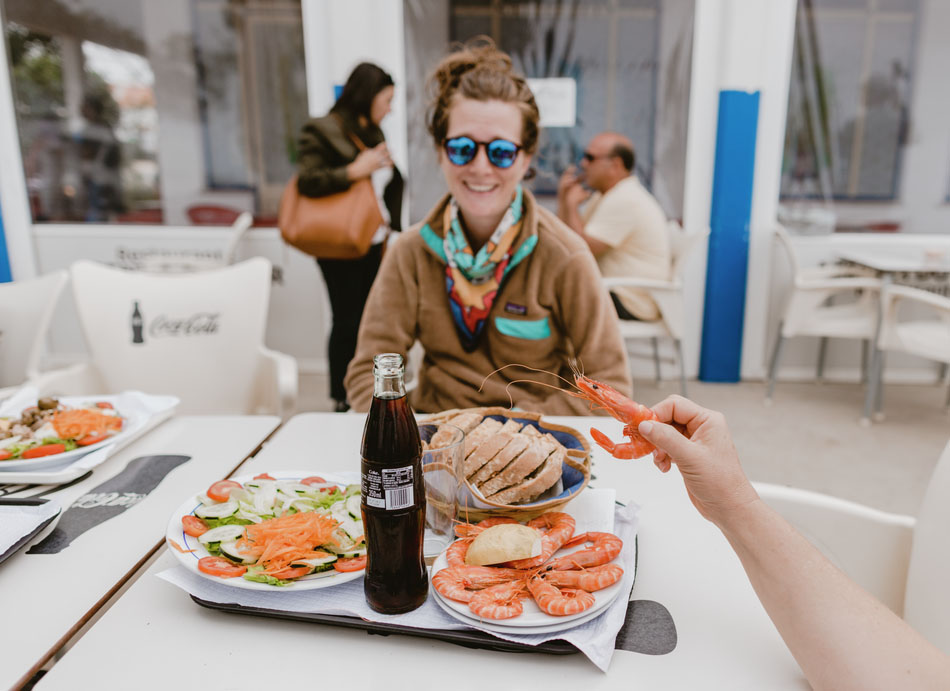
Just-caught seafood and still-warm fresh bread—washed down with a soda.
Aside from seafood, make sure to sample Lisbon’s bifana sandwiches and test your appetite with Porto’s own breaded masterpiece, the francesinha.
And, of course, Portugal is a delight for wine enthusiasts. Port is a must, but the country is also home to many refreshing varieties of vinho verde.
Key phrases to know
Bom dia—Good day (standard greeting)
Tudo bem?—How are you?
Obrigado(a)— Thank you
